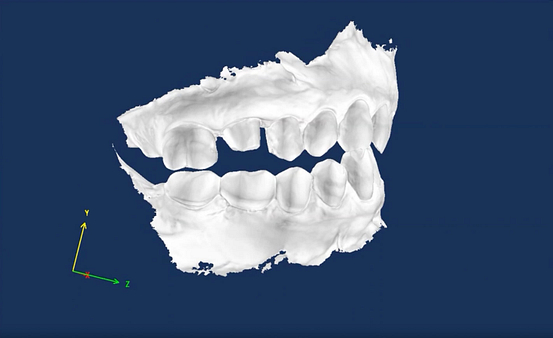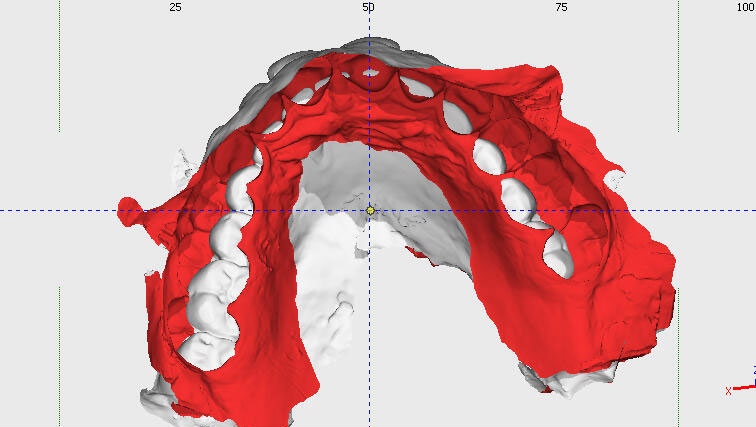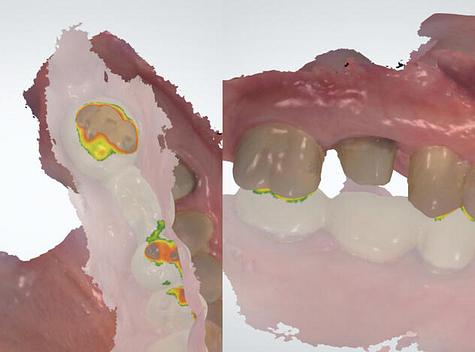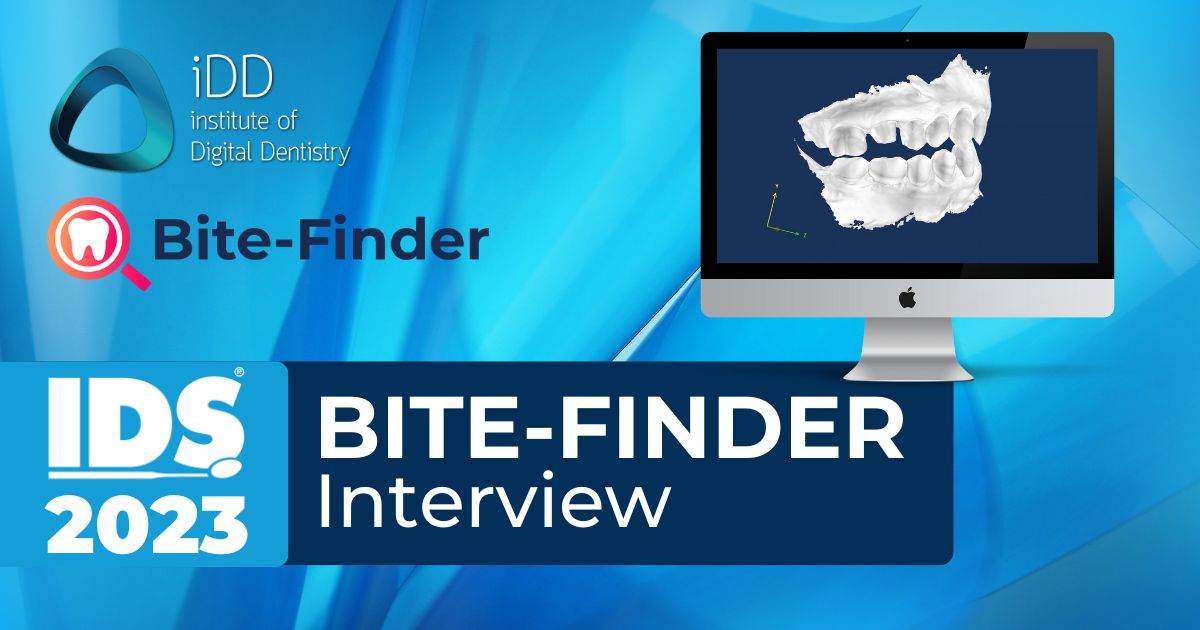Artificial Intelligence has been dominating the news cycle as of late, and it’s no different in the dental industry. During our recent trip to IDS 2023, we saw so many new and exciting innovations in dentistry using AI, which prompted us to further explore the role of AI in dentistry.
One interesting company we met at IDS was Bite-Finder, a software company that uses AI to fix dental occlusion and detect high spots in models with just one click.
We chatted with Björn Zäuner, Bite-Finder’s Chairman to find out more about their software.
You can watch the whole blog below or enjoy the transcript.
All images have been sourced from Bite-Finder.
Can you tell us about this unique jaw motion solution tool that was recently launched?
Yes! It’s jaw motion and also static occlusion. Which currently is where the problem comes from. Most of the scans we receive have penetrations, or they have air bubbles and sometimes even completely off.
It’s common knowledge that the majority of the scans that labs receive are wrong, no matter the software. It also happens with lab scanners. They create from a technological point, and they cause errors, which results in slight grinding, and in a fully digital workflow, this is the bottleneck.
That's why we developed Bite-Finder. By putting two models, upper and lower jaw together, you can just press one button, and then the magic happens. We calculate the perfect bite. We do what you do by hand with two stone models. We find the one point where the occlusion is.
Based on that, we can now also create jaw movements automatically. By not allowing penetration, we open up the lower jaw in every possible way. Taking into account the fissures, the abrasions, and the individual teeth. Imagine putting jaw motion data on a wrong static occlusion. If you have penetrations or your bite is a little off, and you put jaw motion on it, it makes the problem even worse.
It doesn't help you. So depending on a medical indication, after correcting the bite with Bite-Finder, you either use our dynamic jaw motion, which is AI-based or use Zebris or Modjaw, if you have a very special case.


Before and after using Bite-Finder's AI
Can you integrate other software as well?
Not at this moment, we don't want to completely disrupt their technology because it’s beneficial if you have a special case.
But, It's very expensive, and it takes a lot of time. You probably won't use it for a single crown or a small bridge. Most likely will be used for complex cases.
What was the inspiration for Bite-Finder?
The idea was to stop using impression material. We didn’t have high penetration in the intraoral scanner market.
We received a lot of impressions, and we can scan impressions, but it is still impossible because we need a bite registration. In 50% of cases, we get a physical bite, silicone, or wax and at least 50% are not usable. They might be used for reference, but it doesn't help you in a digital process because it will be too far off anyhow to get a perfect bite.
The solution was born in the lab. We suffered with this problem as every other lab suffers and we had a lot of great beta testers worldwide. Big labs, small labs, boutique labs, dentists, and orthodontists test it.
And the result is great. They loved the results because they don't have to manually adjust them in the lab. The dentist is happy because he doesn't have to adjust the bite because chair time is expensive.
So beautiful restorations won’t get destroyed with occlusal adjustment anymore.
Exactly. Because now, with our perfect static occlusion, you have perfect occlusion of the crown with our dynamic jaw motion. Also, you’ll avoid early contact in the movements. So you don't have to design a potato anymore! You can make a beautiful crown because you know how the jaw will open and close and take that into consideration when you design your crown or bridge. It's just one click. It's a fully automated process. It's working very well, and it's easy to use.
How long does the process take and how much is it?
It's a cloud-based process, so we have a desktop application. You process two models, upper lower OBJ, STL, PLY, doesn't matter. We can also handle color because it's a very highly complex computation process.
Everybody knows ChatGPT. AI pictures and texts are easy to handle. We handle 3D data, a single jaw scan can be 50 megabytes, and it's a very complex process. So we need high-performance computing.
That's why it cannot be put on a regular PC in the lab because nobody wants to buy a 100k computer in the lab.
There are computer costs and energy costs to run these servers. I understand?
Exactly. It takes an average of between 30 to 90 seconds, depending on the file size and how many features you want. If you want to, in one click you can get repair and reduction.
We close all the holes of the scan, we remove artifacts. If the file is very big because you scanned slowly or have too many images, you get a jaw scan, which is like a hundred megabytes. So we give you the option to say maximum deviation, the maximum error of two microns and we reduce like a hundred-megabyte scan to 40 without a big loss.
So you simplify the mesh matrix?
Correct. Which will improve the CAD workflow. It makes everything faster and some CAD programs don't accept any jaw scan of more than 60 megabytes. After that, we find perfect static occlusion and dynamic occlusion. We also have automatic 3D printable models.
So we close them. We put the final name as a label on top, and we generate a video that documents the whole process, which you can send to the dentist or the patient. You get everything in one folder, two STLs', the correct position, an XML file with the jaw motion, and the video. Then you can go on with your design process in exocad, 3Shape, or the software of preference.
That sounds exciting! What's the dollar value?
Dollar value is peruse. So it's flexible pricing, and no investment is needed. Depending on your usage. We have two options, like a cell phone contract. Prepaid, or monthly base or yearly based pricing.
The average cost would be something between $5 to $10, but for very big labs or enterprises, it varies.
Subscription plans for large and small users.
Yes. For example, a small lab pays $49 a month. They will get their credits. They can use it to fix whatever they receive.
The other option is to contact the dentist and say, “Please make a new scan”, and nobody wants to do that!
That's very costly.
It's very costly, it’s time and money. Or you can 3D print the models, put them in occlusion, and scan them again in your lab scanner. And usually, it's a delay of at least one day.
The material incurs a cost and acts as a bottleneck. Nobody wants to do that in a digital workflow because it’s not productive and it doesn't make any sense.
There's the time in the lab and the wasted labor there.
Exactly, and for big customers, we also have a serial computation. You can create a folder, put 100 cases in and they will be queued and calculated. Plus we also have API integrations in two systems for very, very big customers.
You have the option to upload batches of files into a folder, and there is also an API integration available.
It will be automatically fixed. We can directly go on with your designs.
If you have to involve your supervisor in the lab, it can result in a loss of money. In today's world, when it's so affordable to design crowns, you get crowns for $50 in the US. But just for putting a hand on it, you lose money.
That's why you have to have an efficient workflow.
Well, this sounds like a really exciting solution. Looking forward to trying it out.
Perfect. Thank you.

